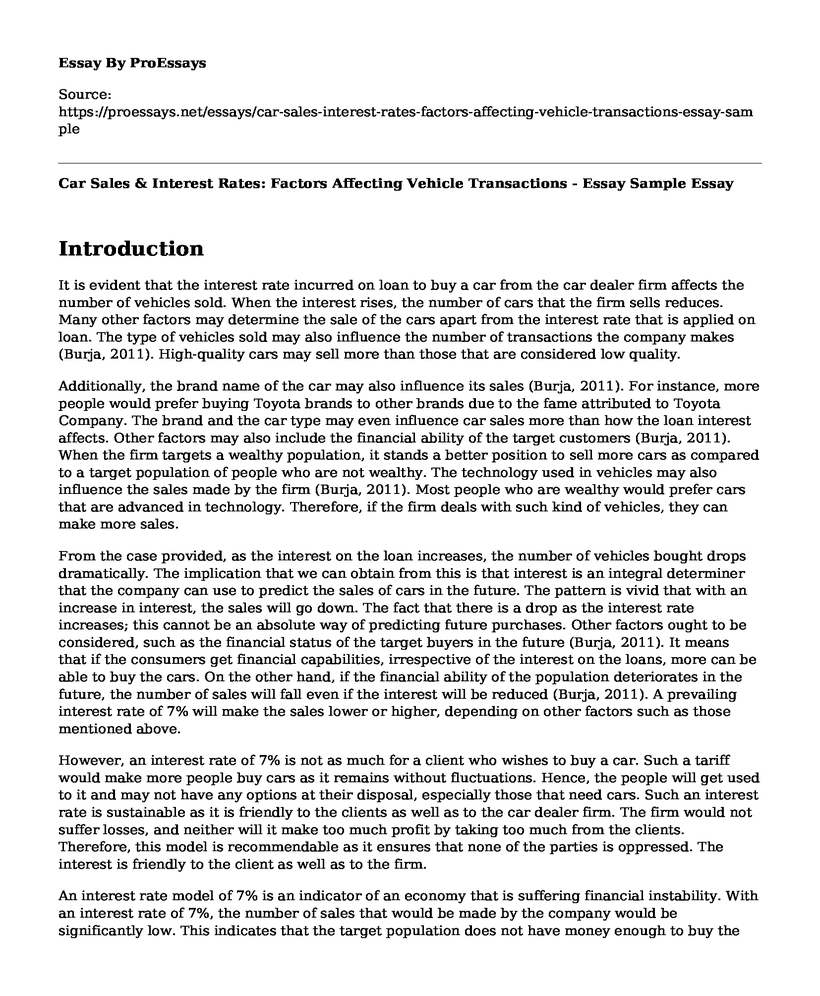Introduction
It is evident that the interest rate incurred on loan to buy a car from the car dealer firm affects the number of vehicles sold. When the interest rises, the number of cars that the firm sells reduces. Many other factors may determine the sale of the cars apart from the interest rate that is applied on loan. The type of vehicles sold may also influence the number of transactions the company makes (Burja, 2011). High-quality cars may sell more than those that are considered low quality.
Additionally, the brand name of the car may also influence its sales (Burja, 2011). For instance, more people would prefer buying Toyota brands to other brands due to the fame attributed to Toyota Company. The brand and the car type may even influence car sales more than how the loan interest affects. Other factors may also include the financial ability of the target customers (Burja, 2011). When the firm targets a wealthy population, it stands a better position to sell more cars as compared to a target population of people who are not wealthy. The technology used in vehicles may also influence the sales made by the firm (Burja, 2011). Most people who are wealthy would prefer cars that are advanced in technology. Therefore, if the firm deals with such kind of vehicles, they can make more sales.
From the case provided, as the interest on the loan increases, the number of vehicles bought drops dramatically. The implication that we can obtain from this is that interest is an integral determiner that the company can use to predict the sales of cars in the future. The pattern is vivid that with an increase in interest, the sales will go down. The fact that there is a drop as the interest rate increases; this cannot be an absolute way of predicting future purchases. Other factors ought to be considered, such as the financial status of the target buyers in the future (Burja, 2011). It means that if the consumers get financial capabilities, irrespective of the interest on the loans, more can be able to buy the cars. On the other hand, if the financial ability of the population deteriorates in the future, the number of sales will fall even if the interest will be reduced (Burja, 2011). A prevailing interest rate of 7% will make the sales lower or higher, depending on other factors such as those mentioned above.
However, an interest rate of 7% is not as much for a client who wishes to buy a car. Such a tariff would make more people buy cars as it remains without fluctuations. Hence, the people will get used to it and may not have any options at their disposal, especially those that need cars. Such an interest rate is sustainable as it is friendly to the clients as well as to the car dealer firm. The firm would not suffer losses, and neither will it make too much profit by taking too much from the clients. Therefore, this model is recommendable as it ensures that none of the parties is oppressed. The interest is friendly to the client as well as to the firm.
An interest rate model of 7% is an indicator of an economy that is suffering financial instability. With an interest rate of 7%, the number of sales that would be made by the company would be significantly low. This indicates that the target population does not have money enough to buy the cars even with a low-interest rate. As we found out earlier, the economic state of the country determines how much money is circulating among the citizens. When little cash is flowing among the citizens to a point they cannot afford what they need, that would be an indicator of an economy that is not doing fine. With the reduced number of car buyers even with a low-interest rate, the dealership firm would experience losses or small margin profits, which might not be sufficient to sustain the venture.
References
Burja, C. (2011). Factors Influencing the Companies' Profitability. Annales Universitatis Apulensis: Series Oeconomica, 13(2), 215.
Cite this page
Car Sales & Interest Rates: Factors Affecting Vehicle Transactions - Essay Sample. (2023, Mar 07). Retrieved from https://proessays.net/essays/car-sales-interest-rates-factors-affecting-vehicle-transactions-essay-sample
If you are the original author of this essay and no longer wish to have it published on the ProEssays website, please click below to request its removal:
- Hotel Liability Essay
- The Fundraising Activity of the Rexdale Women's Centre Paper Example
- Essay Example on Crypto Assets: Cryptocurrencies and Tokens Explained
- Essay Example on Credit Rating Agencies Analyze Firms' Financial Capabilities
- Essay Sample on Universal Health Coverage: Economic Merits and Demerits
- Research Paper on Police Officers' Interactions Captured with Body-Worn Cameras
- Umpqua Bank: Dysfunctional Operations Management System Leads to Confusion - Essay Sample







